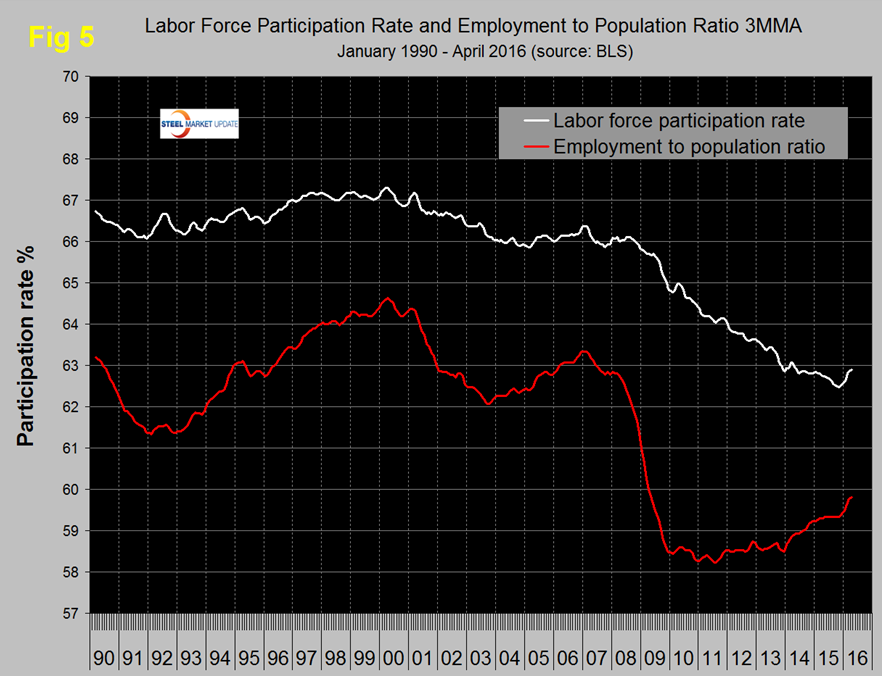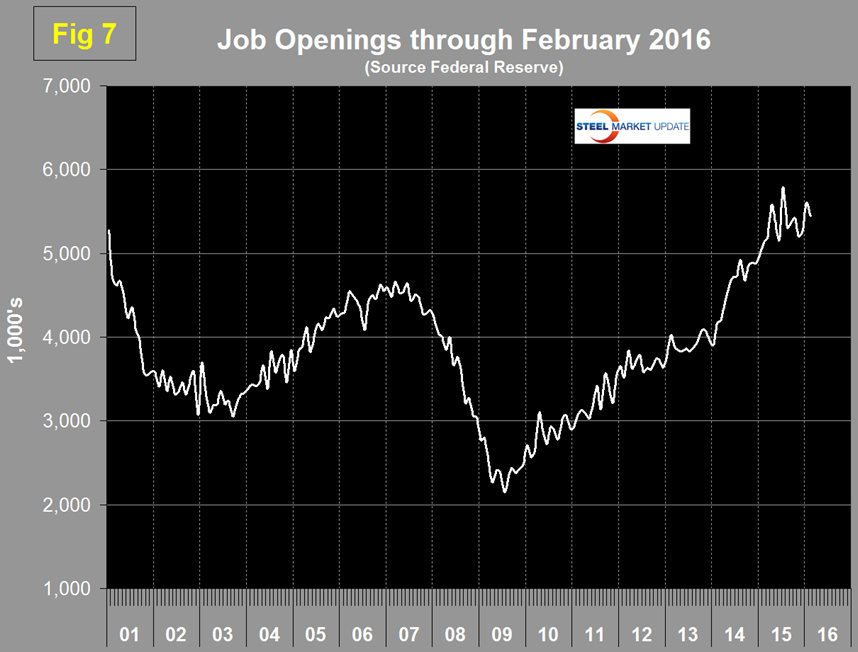Economy

Net Job Creation by Industry through April 2016
Written by Peter Wright
May 6, 2016
The Bureau of Labor Statistics (BLS) reported on Friday in their analysis of non-farm employment that 160,000 jobs were added in April, down from 208,000 in March. February and March were revised down by a total of 19,000. An explanation of the BLS report is included at the end of this piece.
![]() The three month moving (3MMA) of gains through April was 200,000, down from 203,000 in March. The unemployment rate, U3, calculated from a different survey, remained unchanged in April at 5.0 percent and up from 4.9 percent in February. Monthly job gains have averaged 220,000 per month in the sixteen months since and including January 2015 (Figure 1).
The three month moving (3MMA) of gains through April was 200,000, down from 203,000 in March. The unemployment rate, U3, calculated from a different survey, remained unchanged in April at 5.0 percent and up from 4.9 percent in February. Monthly job gains have averaged 220,000 per month in the sixteen months since and including January 2015 (Figure 1).
These numbers are seasonally adjusted by the BLS so to examine if any seasonality is left in the data after adjustment we have developed Figure 2 which suggests that the adjustment is less than perfect.
On average since 2011 April’s number of jobs created has increased by 15 percent from March on a seasonally adjusted basis, this year there was a 23 percent decrease therefore we conclude that April’s data in a longer term context was worse than it appears at first glance. Total nonfarm payrolls are now 5,550,000 more than they were at the pre-recession high of April 2008.
Table 1 slices total employment into service and goods producing industries and then into private and government employees.
Total employment equals the sum of private and government employees. It also equals the sum of goods producing and service employees. Most of the goods producing employees work in manufacturing and construction and the major components of these two sectors are also shown in Table 1. In April, 171,000 jobs were created in the private sector and 11,000 were lost in government. The Federal government lost 9,000 as state governments lost 2,000 and local governments were unchanged. Since February 2010, the employment low point, private employers have added 14,581,000 jobs as government has shed 399,000. In April service industries expanded by 163,000 as goods producing industries lost 3,000 people. Since February 2010, service industries have added 12,130,000 and goods producing 2,052,000 positions. This is part of the reason for stagnant wage growth since service industries on average pay less than manufacturing.
The good news in April was that job creation in manufacturing industries was positive after back to back poor results in February and March. Manufacturing added 4,000 jobs in April but has only added 9,000 in the 16 months since and including January last year. Table 1 shows that in April manufacturing was propped up by the transportation equipment sector and that most of that strength was in automobiles and parts. Truck transportation also had positive growth after two loosing months. Oil and gas and primary metals continued their losing streaks which have extended for 13 and 10 months respectively. Note the subcomponents of both manufacturing and construction shown in Table 1 don’t add up to the total because we have only included those that have most relevance to the steel industry. Construction has leapt ahead of manufacturing as a job creator but it must be recognized that productivity increases in manufacturing are very much greater than they are in construction.
Construction added 1,000 jobs in April for a total of 369,000 in the 16 months since and including January 2015. Some of the major construction sub categories are routinely reported one month in arrears which distorts the data in Table 1. These include, industrial buildings, commercial buildings and highways and streets. Construction has added 1,170,000 jobs and manufacturing 844,000 since the recessionary employment low point in February 2010 (Figure 3).
Based on the total construction analysis that we report in our CPIP update, we assume that construction jobs will continue to expand vigorously.
The official unemployment rate known as U3, decreased from 5.5 percent in May last year to 4.9 percent in January and February before increasing again to 5.0 percent in March and April. This number doesn’t take into consideration those who have stopped looking. The more comprehensive U6 unemployment rate decreased from 11.3 percent in January 2015 to 9.7 percent in this latest data (Figure 4).
U6 includes workers working part time who desire full time work and people who want to work but are so discouraged that they have stopped looking. The differential between these rates was usually less than 4 percent before the recession but is still 4.7 percent. The gap is slowly closing.
The employment participation rate is widely quoted in the press as going nowhere. In April 2016 the rate was 62.8 percent which was the same as October 2013. There has been an uptick from a low of 62.4 percent in September last year. We’re not sure that we understand what this is a percentage “of” because of the multiple descriptions of the labor pool. Another measure is the number employed as a percentage of the population which we think is much more definitive. In April this measure stood at 59.7 percent which was up from 58.8 percent in January 2014. Figure 5 shows both measures on one graph.
Since and including January 2015 there has been an increase of 3,260,000 full time and of 291,000 part time jobs. Figure 6 shows the rolling 12 month total change in both part time and full time employment.
Frequently in the press we read that a large part of job creation is in part time employment. This is not the case but because the part-time numbers are extremely volatile we have to look at longer time periods than a month or even a quarter to get the picture.
The job openings report known as JOLTS is reported on about the 10th of the month by the Federal Reserve and is over a month in arrears. Figure 7 shows the history of unfilled job openings which have skyrocketed in the last two years to levels not seen since the data series was initiated in 2000.
The previous high was 5.25 million at the end of 2000; in the last two years we have seen a surge from 3.906 million in January 2014 to 5.445 million in the latest report for February 2016.
Initial claims for unemployment insurance increased slightly to 274,000 in week ending April 30th but the labor market continues to gradually tighten. The four week moving average of new claims rose by 2,000 from the previous week, which was the lowest number of new filings since December 8, 1973.
Explanation: On the first Friday of each month the Bureau of Labor Statistics releases the employment data for the previous month. Data is available at www.bls.gov. At SMU we track the job creation numbers by many different categories. The BLS data base is an excellent reality check for other economic data streams such as manufacturing and construction and we include the net job creation figures for those two sectors in our “Key Indicators” report. It is easy to drill down into the BLS data base to obtain employment data for many sub sectors of the economy. For example, among hundreds of sub-indexes are truck transportation, auto production and primary metals production. The important point about each of these hundreds of data streams is in which direction they are headed. Whenever possible we at SMU try to track three separate data sources for a given steel related sector of the economy. We believe this gives a reasonable picture of market direction. The BLS data is one of the most important sources of fine grained economic data that we use in our analyses. The States also collect their own employment numbers independently of the BLS. The compiled state data compares well with the federal data. Every three months SMU examines the state data and provides a regional report which indicates strength of weakness on a geographic basis. Reports by individual state can be produced on request.

Peter Wright
Read more from Peter WrightLatest in Economy

Consumer auto delinquencies: Warning sign for consumer health?
The Consumer Federation of America estimates rising total auto debt at a staggering $1.66 trillion, along with increasing repossessions and a sharp increase in delinquencies.

Beige Book: Regional market growth remains mostly flat
Economic growth in some US regions in September was offset by challenges in others, causing the market to appear largely unchanged overall, according to the Federal Reserve’s latest Beige Book report.

ISM September survey captures deepening manufacturing gloom
The Institute for Supply Management’s (ISM) latest monthly report on manufacturing reflects a bleak view of American industry in September.

Key industries concerned over government shutdown’s impact on steel, manufacturing
Trade groups cautioned that a prolonged shutdown could strain US industry.

Chicago Business Barometer catches cold winds of contraction in September
The Chicago Business Barometer's September reading indicates a softening in overall business activity in the Midwest for the third consecutive month, with new orders and backlogs retreating further.








